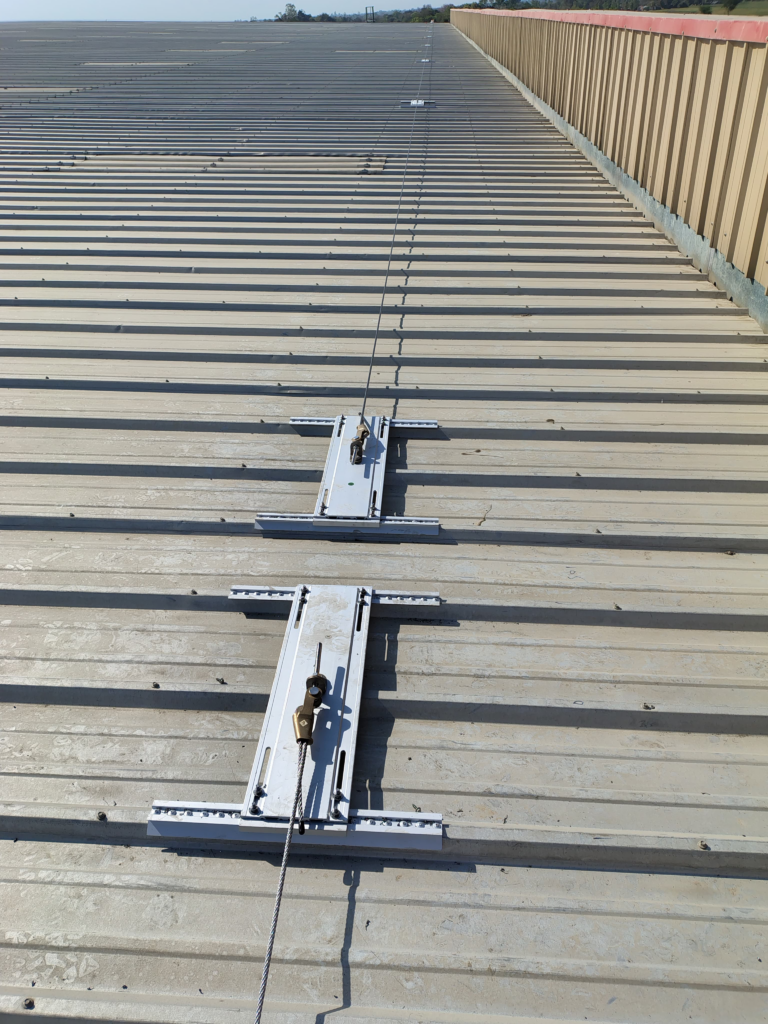The rooftop is a place of breathtaking panoramas and unparalleled utility. But for those who work on rooftops, it can also be a realm of inherent danger. Even a minute slip can result in a disastrous fall. Thankfully, a reliable guardian angel watches over these modern-day roof walkers: the horizontal lifeline system.
What is a Horizontal Lifeline System?
Imagine a safety net woven from steel, a tightrope walker’s guide for the rooftop. That, in essence, is a horizontal lifeline system. A lifeline system typically consists of a cable or rail securely fastened to a roof structure at predetermined intervals. These lifelines are paired with full-body harnesses and lanyards, creating a secure tether that restricts a worker’s fall distance in case of a slip or misstep.
The Horizontal Lifeline system is an exceptional solution for fall protection on rooftops. Its galvanized steel cable provides a sturdy and continuous anchor for workers, ensuring maximum safety. The system’s modular design is highly customizable, allowing to adapt to various roof shapes and configurations quickly. The horizontal Lifeline system offers unparalleled fall protection for workers, making it an excellent investment for any rooftop maintenance or construction project.

Why Use a Horizontal Lifeline System?
While fall protection equipment like guardrails can provide a measure of safety, they often come with limitations. Guardrails can restrict movement and access to some regions of the rooftop. Horizontal lifelines, on the other hand, offer a distinct advantage: unrestricted mobility.
Imagine a technician maintaining rooftop HVAC units scattered across a vast, sprawling roof. With a horizontal lifeline system, the technician can move freely and efficiently from unit to unit, all while remaining securely connected to a lifeline. This not only enhances worker safety but also improves productivity.
Here’s a closer look at the compelling benefits of horizontal lifeline systems:
- Unmatched Freedom of Movement: Unlike guardrails that create a physical barrier, horizontal lifelines allow workers to move freely across the entire rooftop, providing easy access to all work areas.
- Enhanced Safety: The primary function of a horizontal lifeline system is to prevent falls. In the unfortunate event of a slip or trip, the lifeline system arrests the fall, minimizing the distance and potential for injury.
- Versatility: Horizontal lifeline systems can be configured to fit a wide range of roof shapes and sizes, making them suitable for various rooftop applications.
- Ease of Use: Modern horizontal lifeline systems are designed for user-friendliness. Donning and adjusting the lanyards and harnesses is simple, allowing workers to focus on their tasks without being hindered by complex safety equipment.
- Cost-Effectiveness: While the initial investment in a horizontal lifeline system may seem substantial, it pales compared to the potential costs associated with a fall from a height. Furthermore, horizontal lifelines are durable and require minimal maintenance, making them a value-for-money solution in the long run.
Applications of Horizontal Lifeline Systems
The applications of horizontal lifeline systems are as diverse as the roofs themselves. Here are some of the common scenarios where horizontal lifelines play a vital role in ensuring worker safety:
- Rooftop Maintenance: Routine maintenance tasks on rooftops, from inspecting HVAC units to cleaning gutters, carry the inherent risk of falls. A horizontal lifeline system provides a vital safety measure for technicians performing these essential tasks.
- Construction Projects: During the construction of a new building, roofers and other workers are often exposed to fall hazards. A horizontal lifeline system can safeguard these workers throughout the construction process.
- Telecommunication Work: Telecommunication technicians frequently need to access rooftops to install and maintain equipment. Horizontal lifelines offer crucial fall protection for these workers.
- Wind Turbine Maintenance: To service these massive structures, wind turbine technicians venture to great heights. Horizontal lifelines are essential safety equipment for these high-risk operations.
Choosing the Right Horizontal Lifeline System
With many horizontal lifeline systems available, selecting the right one for your needs is crucial. Here are some key factors to consider:
- Roof Type and Size: The type and size of your roof will significantly influence the design and configuration of the horizontal lifeline system. A qualified professional can assess your roof and recommend an appropriate system.
- Number of Users: The number of workers who will be using the lifeline system simultaneously will influence the weight capacity requirements of the system.
- Compliance Standards: Ensure the chosen horizontal lifeline system meets all relevant safety standards and regulations.
